| The
Caller - The person who gives the instructions (ie calling) the dance. |
|
| The
Set - The collective term for the dancers. |
|
| The
Formation - The position from which the dance is started. There are
many different formations, the most common being: |
|
|
Circle
- A circle around the room with the lady on the right of her partner.
|
|
|
Longways
- Everyone faces their partner to make two long lines with the men on
the caller's right and the lady on the caller's left. The set may have
any number of couples, but some dances may have a fixed number such as
three, four or five couples.
|
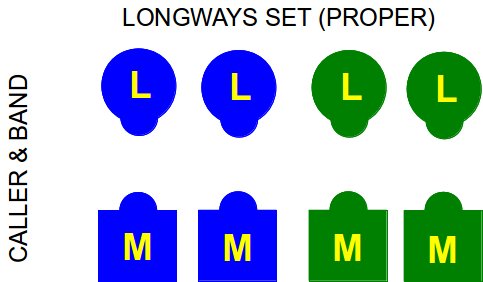
|
|
Sicilian
Circle - Couple facing couple and each group of four making a larger
circle around the room.
|
|
Square
- A four couple set with each couple on the side of a square with the
lady on the right of her partner.
|
|
Beckett
Formation - A longways set but with the lady on the right of her partner
facing another couple across the set.
|
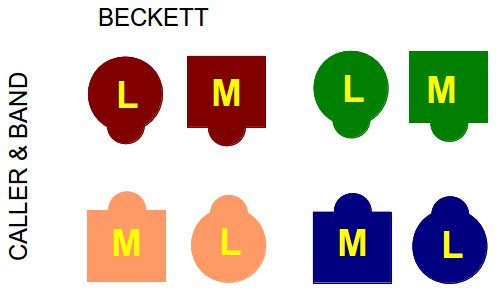
|
Hands
Four - This is a term used by callers when a set is being made up, to
define first and second couples. This divides a longways set into subsets
of two couples who temporarily hold hands to make rings of four. The couples
nearest the band and the caller become the first couples, with the others
becoming the second couples. Sometimes hands 6 or 8 may be used for special
dances - see also Triple minor below.
|
|
Progression
- Many longways sets will have started off with "Hands Four". The progression
will be for each first couple to move down the set to a new second couple
and each second couple to move up the set to a new first couple. When
a couple reach either end of the set they normally stand out for one turn
of the dance. If it is an "improper" dance, couples should change sides
with their partner whilst standing out. For Beckett dances, couples progress
down one side of the set, across the end and up the other side of the
set.
|
Proper
and Improper - A proper dance is one as described in "Longways" above
where all the men are on one side of the set and all the ladies on the other.
An improper dance is where the first couples have crossed over with their
partners in a longways set. An indecent
dance has the second couple crossed over instead of the first couple (mainly
in contra dances).
|
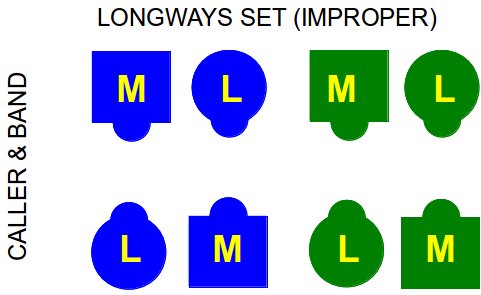
|
Triple
minor - Some longways sets work with three couples dancing together
rather than two couples. In this case the caller will have started with
"Hands Six" rather than "Hands Four".
|
|
Allemande Left
- Give left
hand palm to palm to your partner or to whoever instructed and walk a
complete turn anticlockwise back to place.
Allemande Right
- Give right
hand palm to palm to your partner or to whoever instructed and walk a
complete turn clockwise back to place.
For
safety, during an allemande it is considered good practice to keep
the thumb flat against the hand rather than hook the thumbs around each
other. There have been cases of dislocated thumbs during energetic allemandes
when one dancer doesn't release quickly enough.
|
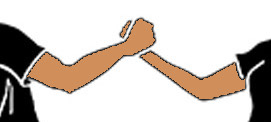
|
| Back
to Back (also called a Do-Si-Do ) -Take two steps forward (to
just pass partner's right shoulder), one side step to the right and two
in reverse passing left shoulder to finish back in place. |
| Box
the Gnat - Man's right hand to lady's right hand, both walk forward
passing right shoulders. Lady twirls away from the man as she goes under
the arch. Each will be standing in the other's original position and facing
each other. |
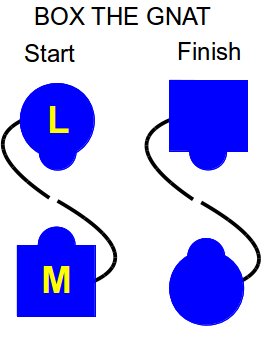
|
| California
Twirl - Man's right hand to lady's left hand, the lady walks under
the arch as they trade places and face the opposite direction from the start
of the figure. |
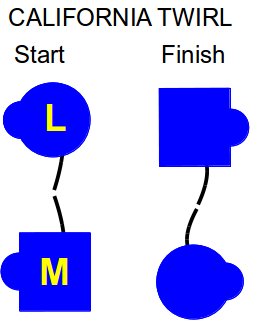
|
Cast
- Turn away from partner and move to the position instructed.
|
Changes
of 2, 3 or 4 - (of a hey, or of a circular hey, or of a square through)
is similar to right and left through but without the courtesy turns. It
may also be done without hands and just passing shoulders.
|
|
Double
Figure of 8 - See figure of 8, but done by two couples at the same
time around each other.
|
Circle
Left (or right) - 3 or more dancers join hands and circle to their
left (or right).
|
| Figure
of 8 - One couple stands still whilst the other couple, with the
lady passing in front of the man, go between them, around the person on
the opposite side of the set, between them again and around the other stationary
person to finish back in place. |
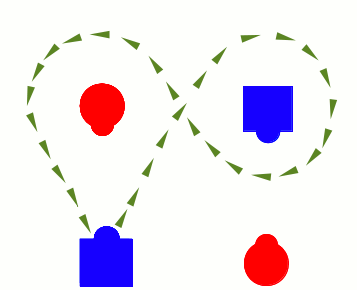 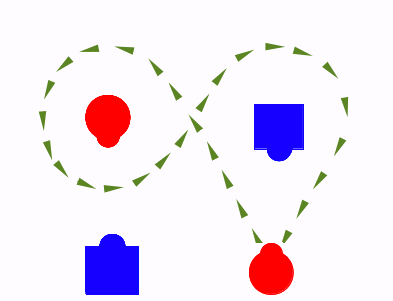
Man's
track Lady's
track
|
| Gender-free
Calling - Calling a dance without reference to gender i.e. the use of
men/women, or ladies/gents. Instead, Larks and Robins are used, which translates
back to men and women. Also see Positional Calling. In contradancing it
is becoming more common for people to dance either role i.e. men dancing
what was the ladies role and vice-versa, and to swap roles during the dance.
This gives the opportunity to experience the whole dance, rather
than just one role. |
Gypsy
Right or Left - Facing partner (or whoever instructed to gypsy with)
and circle around each other to the left or right (as instructed) without
hands until back to where started, all the time gazing into that person's
eyes (it's a flirting move). Also see Right Shoulder Round.
|
Gypsy
Meltdown - Gypsy right one full turn then naturally go into a swing.
A contradance move. The call is now 'Right shoulder round then melt into a swing'. Quite a mouthfull!
|
Grand
Chain - Walk around a circle (men go anticlockwise, ladies go clockwise) or along a line giving alternate hands
for the number of times (hands) instructed or until back to place. Normally
started with the right hand.
|
Honour
- Face partner (or whoever instructed) and step to right, stay there and
acknowledge that person. Often followed by step left and acknowledge.
|
Ladies
Chain - With two couples facing and a lady on the man's right. The
ladies cross the set, giving right hands to each other to pull by and give
left hand to the opposite man's left. The man puts his right arm around
the lady's waist to turn her around (courtesy turn) so that the two couples
are again facing and the lady is on the right. Often (but not always) the
movement is repeated from the opposite side so that the ladies get back
to place. In positional calling this will be a Right-hand chain.
|
|
All
Four Ladies Chain - Similar to ladies chain but often done from
a square formation. The four ladies give right hands to make a star and
go half way around to the opposite man who courtesy turns her out of the
chain.
|
Left
Hand Star - Usually danced by two couples giving left hand to the
diagonally opposite person to form a cross and walking in an anti-clockwise
direction to finish back in place.
|
Lead
- Take nearest hand with partner and move as instructed.
|
Left
Hand Turn - The man gives his left hand palm up and the lady puts
her left hand into his, palm down. Walk
a complete anticlockwise turn back to place. Gently
grip (without thumbs) so that each dancer can pull away easily - it has
been known for a dancer to grip tightly and not let go!
|

|
| Men's
Chain - With two
couples facing and a lady on the man's right. The men give left hands to
each other to pull by and give right hand to the opposite ladies left. The
lady puts her left arm around the man's waist to turn him around (courtesy
turn) so that the two couples are again facing and the lady is on the man's
right. This move is rarely done but more (contra) dances are being written
incorporating it. In
positional calling this will be a Left-hand chain. |
Mezcolanza
- sets of normal-facing lines of four i.e. two couples facing two
couples, with the sets stacked up lengthwise down the hall away from the
band. The lines of four with their backs to the band progress down the hall
away from the band, while the lines of four facing the band progress up
the hall. Within each set of four, couples usually change ends with each
turn through the dance, as part of the dance.
|
| Positional
Calling - Calling a dance without reference to men/women or larks/robins.
Instead, the positon of the dancer is used, and which hand happens to be
free i.e. right-hand chain where the person on the right of the couple uses
their right hand to pull by the person on the opposite side of the set. |
Pousette
Full
pousette: Give two hands to partner and with one pushing (as instructed)
forward four steps moving slightly to the side and reverse back into other
couples place. Continue with other partner pushing to return to place.
Half pousette: Give
two hands to partner and with one pushing (as instructed) forward four
steps moving slightly to the side and reverse back into other couples
place.
Draw pousette: Give
two hands to partner and with one pulling (as instructed) move in a semi-circle
around the other couple. Couples will have swapped places and changed
sides in the set.
|
Promenade
- With lady on man's right hold right hands and left hands and move forward,
usually anticlockwise.
|
Right
and Left Through - Give right hand to opposite person and pull by,
face the next person in the same group of four and give left hand and courtesy
turn to end facing the same opposite person again, but from the opposite
side of the set.
NOTE that right and left through and back means continue the same move until
you are back to place.
|
Reel
or Hey - Usually done with 3 or 4 people who weave in and out along
a straight line until they all get back to Place. Sometimes done as couples
or in two lines at same time as partner.
|
Right
Hand Turn - As for left hand turn but with right hands and walk clockwise.
|
Right
Hand Star - Usually danced by two couples giving right hand to the
diagonally opposite person to form a cross and walking in a clockwise direction
to finish back in place.
|
| Right
Shoulder Round - Slowly replacing Gypsy Right, especially in contra
dancing. Why the change? Something to do with political correctness... |
| Set
(or Balance) - Take a step to the right and bring left foot to it
introducing a slight bounce by putting more weight on the leading foot and
move left foot back followed by the right with a similar bounce. An alternative,
usually used in contra dancing, is to hold both hands with your partner
and step forward and back; the move allows both partners to 'give weight'
and gently pull each other into the next move, often a swing. |
| Siding
(Cecil Sharp) - Facing partner throughout. Walk 4 steps forward passing
partner by left shoulder and 4 steps back passing right shoulder. Also known
as "banana siding" because of the curved shape of the walk. |
| Siding
(Pat Shaw) - Walk 4 small steps forward to be right shoulder to right
shoulder with partner, reverse to place. It may be repeated with left shoulders. |
| Star
Through - Man's right palm to lady's left palm, both walk forward
passing right shoulders. Lady twirls away from the man as she goes under
the arch. Man has turned to the right, lady has turned to the left. |
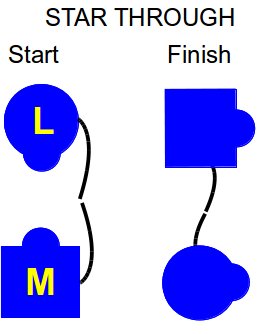
|
| Swat
the Flea - Man's left hand to lady's left hand, both walk forward
passing left shoulders. Lady twirls away from the man as she goes under
the arch. Man has turned to the left, lady has turned to the right. |
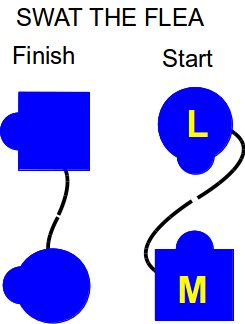
|
Swing
- Using the ballroom hold, men stand slightly to the left of partner and
walk they around each other (this is the American walk swing).
OR
With the same hold, each put the right foot into the centre and use the
left foot to push off as if riding a child's scooter in a circle (this is
the buzz-step swing).
|
Turn Single - Turn on the spot (normally to the right) in four small
steps.
|
Two
Hand Turn - Give two hands to (either your partner or whoever instructed)
and walk a complete turn clockwise back to place.
It is etiquette for the man to hold his hands palm up and for the lady to
put her hands onto his palm down.
|










